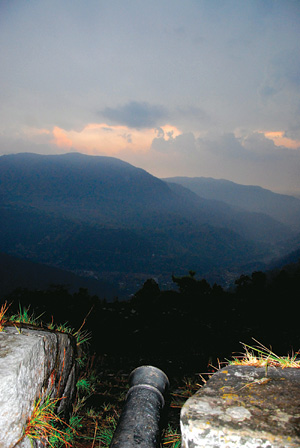Down south in the Tarai is a reason the capital city and the country went unconquered for centuries.
A wet slipp ery mountain road transported me towards the Tarai town of Hetauda. Cresting the last and highest road-pass of Bhimpedi I ascended towards the plains below as lightning blitzed around me and rains hammered mercilessly all those foolish to not have sought shelter. I rode along on a piece of now ‘black-topped’ Nepalese history—its first road—the Mahendra Highway.
ery mountain road transported me towards the Tarai town of Hetauda. Cresting the last and highest road-pass of Bhimpedi I ascended towards the plains below as lightning blitzed around me and rains hammered mercilessly all those foolish to not have sought shelter. I rode along on a piece of now ‘black-topped’ Nepalese history—its first road—the Mahendra Highway.
Shelter came under a teashop’s roof after Bhimpedi. Before me lay only winding roads now with streams gushing over, under the pre-monsoon’s deluge. Nearby lay another chunk of Nepal’s history: the Bituki Bhairav Temple—a fearsome protective deity in Hinduism’s pantheon, locked inside a fortress built of gigantic hewed stone blocks. And, its fearsome arsenal of canons had kept invading armies – such as the British army - out for centuries, keeping Nepal’s central valley secure.
The fort sits on the edge of a sheer cliff, armed with a dominating command of the land on three sides, perched upon one of the highest vantage points. The pujari (temple priest) Man Bahadur Paudel unlocked the key to the historical site. He explained that his family has performed the daily rituals at the temple for hundreds of years, long before King Sen Malla built the fort inside which it now sits.
Man Bahadur requested that I don’t take pictures of the fearsome Kalitop cannon sitting next to the temple. It’s the largest of over a dozen cannons and one can tell it’s the most important with its wheels still intact and safely housed under a roof. Mounds of cannonballs are pilled next to the fearsome object while others adorn the temple’s door. The cannon and its terrifying projectiles are decorated with yellow and red vermillion, connected to the spiritual world albeit a darker side.
I’m shown around the grey walled fortress. Climbing onto its battlements I can see a deep moat cut out as a killing ground for any invader who managed to scale the cliffs and reache the fortress. The fortress was only taken during the mid 18th Century by King Prithvi Naryan Shah who was waging a war to unify Nepal.
Of the smaller cannons laying around, Man Bahadur explained that these are able to reach Hetauda below, Patlaiya over the border in India, Pokhara to the West, the Bagmati to the North and amazingly the feared Kalitop has the ability to hit Lucknow way down to the South. I sat mesmerized by his claims, slightly unbelieving yet happy to accept for the sake of a good tale and to let an old man have his history—who knows maybe it was true! The next time you are heading that way, you might like to ride along the nation’s first roads and witness a piece of Nepali history. ■










